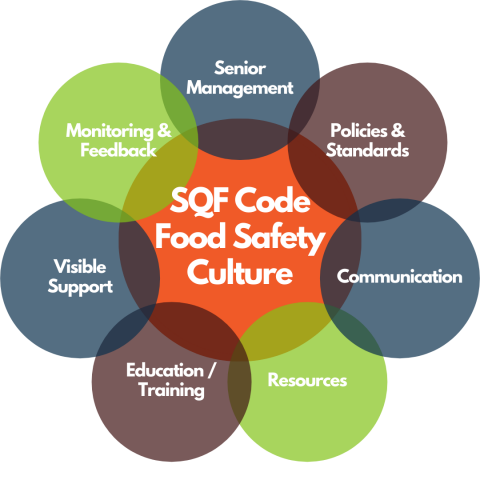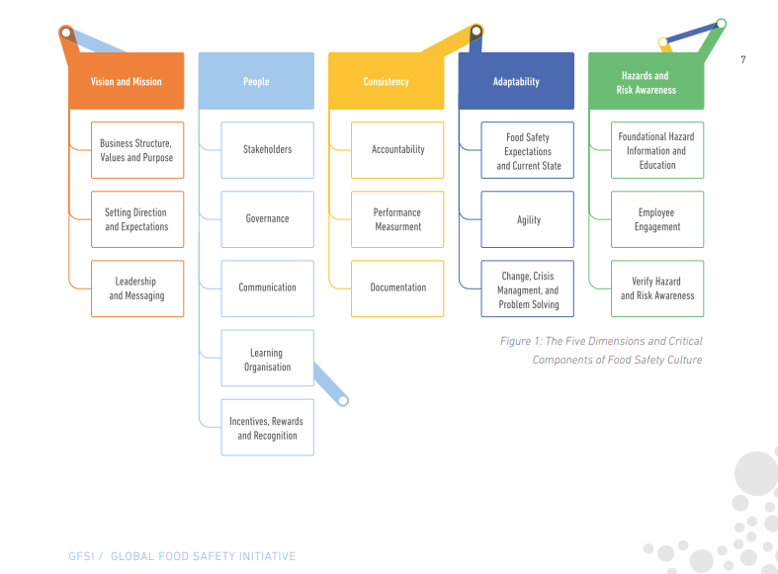The development and success of a food safety program, either as an individual plant or a large corporate food processor, is the commitment by senior management.
GFSI defines food safety culture as “shared values, beliefs, and norms that affect mindset and behavior toward food safety in, across, and throughout, an organization”. This concept of shared values, beliefs, and norms is not part of a prescribed food safety system, but a mindset of behaviors that senior management must embrace and instill throughout the company.
How a Food Safety Culture (FSC) is Implemented and AdjustedSQF and BRC are the predominant systems most recognized in North America.
The SQF Ed. 9 guidance document states that both the plant/company’s team members perform and adhere to the Food Safety Plans even when no one is “watching”. SQF measures all components which are achieved through:
- Communication - Duties & Policies
- Training
- Employee Feedback
- Measuring Performance
The applicable SQF code requirements under 2.1: Management Commitment include:
- 2.1.1.1.ii : Establish and maintain a food safety culture within the site.
- 2.1.1.2: Senior site management shall lead and support a food safety culture within the site.
BRC achieves the same GFSI mandate based on the fundamental clause of senior management commitment and continual improvement. BRC outlines which activities in a plant's operation impact food safety, including annual verification of:
- Proper measurable training
- Open communication and good employee feedback
- Quantification of plant behaviors to keep and improve food safety
- Activity performance quantification of all food safety program activities
- Establishing and monitoring action
A food safety culture ensures all team members are dedicated to implementing the written program into practice, with continual improvements and adjustments. Food safety is a fluid, evolving entity that requires all six components to be integrated.

Resource: SQFi
The GFSI Working Group identified 5 different organizational dimensions or metrics that must be addressed in a flexible manner since FSC is not a “one size fits all” concept.

Resource: GFSI Food Safety Working Group Document April 2018
I. Vision & Mission
Are the policies and objectives of the management’s food safety plan functional and evolving, with strong backing by the senior management team?
II. PeopleA food safety program must embrace farm-to-fork integration of the company.
- Includes strategic direction, organizational structure, employee empowerment, and assessment of capabilities in the food safety program.
- Utilization of a variety of tools for communicating food safety and risk are critical.
- What is the learning environment and organization of the company/corporation?
- What are the behaviors of the company's influencers?
- Are there rewards and incentives given to employees who learn from failures or try to improve food safety practices?
III. Consistency
How is accountability enforced with measuring performance through feedback and documentation?
IV. Adaptability
Food Safety programs are living, evolving dynamic entities.
- Does the organization have agility and flexibility in its program? Does it welcome change and challenges?
- Does it have a robust crisis management team and procedures?
- Can it respond quickly and decisively to critical crisis in order to achieve defined values and outcomes?
- Does an organization’s problem solving skills use insights and events by focusing on root cause analysis with measurable documented corrective and preventive actions?
- Are food safety hazards and risks really understood and measured?
- Why is a particular procedure or function used?
- How does the organization engage its employees in food safety hazards and risks in a flexible, evolving framework?
- Are audits utilized to verify hazard and risk awareness of all plant members, including behavioral observations and near miss analysis?
Conclusion
A food safety culture is not simply just senior management's commitment. It is an entire dynamic system that is constantly assessed and modified. Just like an organization's food safety issues are dynamic and continually posing unique challenges.

